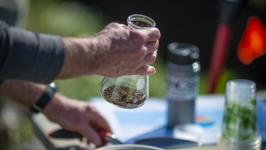My Dirty Two Cents: An Urban Farmer’s Take on Preserving Urban Ag Land
In the 14 years I’ve been farming in Boise, I’ve farmed nine different plots of land I don’t own, farming several plots concurrently in most years. I have some pretty public battle scars as a landless farmer, most notably from the year a landowner bulldozed my farm with ripe crops still in the field because we got in an argument.
Some of the plots I’ve farmed have been turned into massive houses with green chem lawns in a total erasure of countless hours of love, toil and sweat from so many hands. And some of them I lost simply because of the mobile nature of our modern world—sympathetic folks move, new folks move in with other designs on the property and bam!— you’re on the lookout for the next piece of ground to move truckload after truckload of fencing, tools, irrigation line, buckets of dugup raspberry and oregano plants and all the other stuff that makes a farm function.
Finally I settled onto the land at Draggin’ Wing Farm, where Diane Jones makes the most wonderful landowner I can imagine because she too has operated a small farm, so her expectations match the reality of what an urban farm looks like. I hope I never have to leave. We’re at an exciting time in our city’s growth. Amid the tsunami of folks moving from elsewhere into Idaho, the rapid paving over of agricultural land in the Treasure Valley is getting some well-deserved attention. As I write, multiple attempts to protect multiple pieces of ag land are under way. Often I’ve been asked to show up at planning and zoning hearings to lend some in-the-trenches perspective on why it’s so important to preserve farmland. When I explored the latest request and learned which piece was slated to become the next soulless subdivision, I hesitated. No one is farming that land, nor has it been farmed in all the years I’ve been paying attention to it. I realized I have a lot more to say on this subject.
Developers plowing up fertile ground to plant subdivisions is just one threat. I see several issues that must be addressed if we actually want successful and sustainable agriculture on land we’re trying to preserve.
First off, who is going to farm it? Over the last decade I’ve seen at least a dozen folks in our area start and quit small farm operations, for good reason. The economics surrounding agriculture are some of the most depressing and convoluted imaginable. In a culture that worships cheap food and rewards global supply chains, small farmers avoid calculating our hourly wage like the plague because of the heartache and indignation it involves. I can’t count the times I’ve sat in a room of farmers during a presentation where a consultant or university person is telling us to make sure we factor our own time into our business calculations. You can feel the palpable pushing on that particular collective nerve in the room. It’s too hard. It’s too hard to admit to ourselves that we’re pouring our hearts and backs and souls into an enterprise that’s paying us minimum wage, or less.
Which leads to another, related question: Who is going to pay for that land to be farmed? How many of the folks lobbying for the preservation of local farmland are stocking up on cheap groceries at Winco? We eat largely from the exploitation of migrant farmworkers, far away from us, on land we don’t see. I mean, in order to actually create viable small farms, we have to address the issue that the vast majority of Idahoans either don’t want to, or cannot afford to, pay a fair price for the food we eat. It is not mere coincidence that so many of the last remaining agricultural plots of land in the city are lying fallow. It is a combination of factors, including decades of agricultural policy that has made small farms increasingly impossible.
Even if we could figure out a way to pay the farmers stewarding this preserved ag land a living wage by putting them on the city payroll, giving them benefits, subsidizing their work through our tax money—like we do for the industrial commodity farmers or the ranchers grazing cows on public land—who wants an actual working farm in their backyard?
This is perhaps the touchiest subject for me. As we become more urban, with more people who are less connected to the realities surrounding the food they eat, the conflicts between urban homeowners and any remaining agricultural endeavors are surely going to increase. Many of the landowners I’ve worked with over the years have an unrealistic idea of what an urban farm will look like. I’ve had more than one landowner express disappointment because the farm is “too weedy,” with one admitting the truth: that when she has friends over for wine in the evening and wants to walk them out back to show them “the farm,” she wishes it looked better. Suburban culture demands fence-line-to-fence-line maintenance, and if a landowner isn’t up to the task personally, they are completely willing to pay landscapers $25–$50 an hour to make sure that occurs.
Obviously, the irony here is not lost on me: We are happy to pay folks a living wage to maintain our ornamental landscapes, but farmers are often expected to pay landowners for the privilege of stewarding their land. Other no-nos in the suburban aesthetic: manure, flies, bathrooms, junk, traffic, seed stalks, activity at any time of day—all essential components of working farms. And there is an inverse relationship between the level of manicuring that exists in a neighborhood with the level of tolerance for any of the above. The experience of farmers in our area with regard to these issues is so ubiquitous as to almost be a universal truth. Ask anyone who’s been doing this here awhile and they’ll likely agree.
I realize how strange this might seem: an urban farmer seeming to throw cold water on the idea of urban ag land preservation. I am not bringing these issues to light because I think the task of making agriculture a vital part of our community is impossible. I am bringing them up because I think the conversation must expand to include them if any attempt to preserve farmland is to become what the activists fighting to protect it hope for: that they nurture functioning farms, not just fallow, open spaces.









